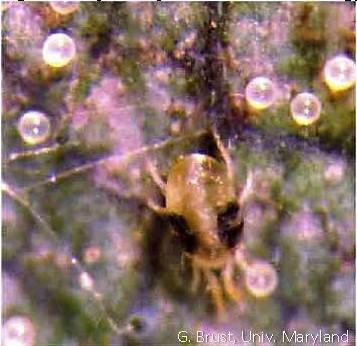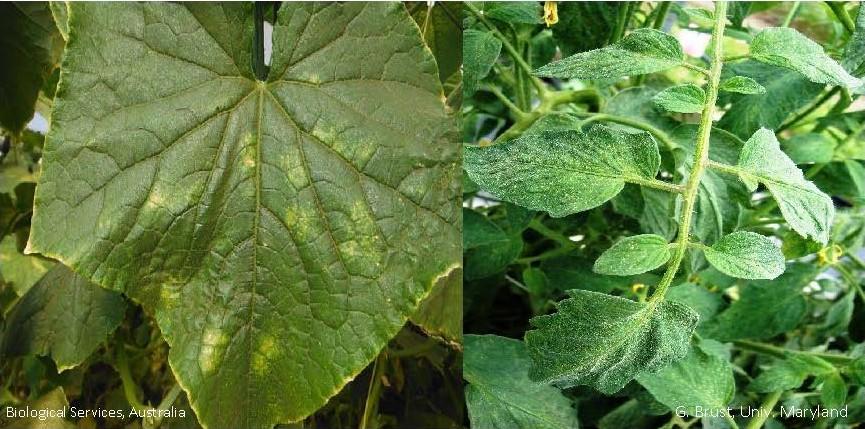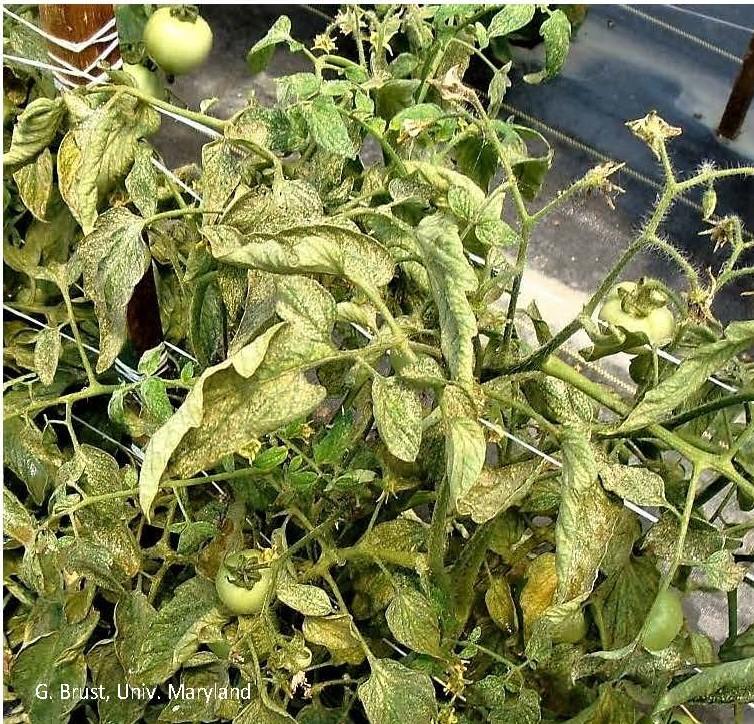Two Spotted Spider Mites on High Tunnel Vegetables
This week I saw several high tunnel tomatoes and cucumbers with moderate to severe two spotted spider mite (TSSM) Tetranychus urticae infestations (fig. 1). These pests vary in color from white to yellow to red. Mites feed by sucking chlorophyll from the plant, which at first appears as small white or yellow marks on the top surface of the leaf (fig. 2). This damage may look like other problems early on and because the mites are difficult to see on the underside of the leaf at this stage of damage their build-up can go unnoticed. The feeding damage then progresses to loss of chlorophyll, yellowing, browning (fig. 3) and eventual death of the leaves or whole plant. They occur in the highest numbers on the undersides of leaves, but when their populations get very high they can move to the top-side of a leaf or onto fruit. Most high tunnel cucumber and tomato cultivars are susceptible to two spotted spider mite damage, however in most of the HTs I was in there were only 4-5 cultivars of cucumber or tomato (out of anywhere from 6-12) that the mites were found on in very high numbers. Growers need to be sure to check all the different varieties of tomatoes and cucumbers they are growing for mite infestations and to specifically check those varieties that are prone to TSSM infestations.
The warm, dry conditions in a high tunnel favor rapid mite development and reproduction, which enables them to complete a generation in as little as 5-7 days which could lead to a 50X increase in the population in just one week. Heavily infested leaves may be covered with very fine, irregular webs in which mites and eggs can be found (fig. 1). Once the spider mites begin to make these webs they are even more difficult to control. This is because the mites hide under the protective layer of webbing making it that much more difficult to get spray coverage to the underside of the tomato leaf.
Early detection is the key for controlling two spotted spider mites. As soon as two spotted spider mites are detected, control efforts need to be taken. Infestations are highest on older leaves and at the base of the leaf near the petiole. Using insecticidal soaps or horticultural oils can work very well if mites are caught early before populations build and severe damage occurs. I have had a few growers who were skeptical of the efficacy of the oils to work on TSSM who were quite pleased by the control they got when they tried them. Thorough coverage of the foliage is critical if the oils are to work.
Biological control of TSSMs with predatory mites is used successfully in greenhouse tomato and cucumber production. How well the predatory mites work depends on the initial pest populations, temperature, humidity and cultural practices that are found in the GH. Usually several releases are required for effective control. But we currently do not have a great deal of information about these predatory mites being effective in high tunnel situations. If used these predators are best utilized as are the organic controls—very early on in a mite infestation.
Because of the frequent harvest intervals for cucumbers and tomatoes the use of some of the synthetic miticides can be limited. Miticides that can be used on high tunnel cucumbers and tomatoes that have a relatively short preharvest interval are Kanemite and Portal XLO, each has a 1-day phi and Acramite which has a 3-day phi. Other TSSM controls that work well but have a longer phi can be found in the 2019 Mid-Atlantic Commercial Vegetable Production Recommendations guide. Some states consider a high tunnel the equivalent of a greenhouse for pesticide use, be sure you know how your state classifies high tunnels.


